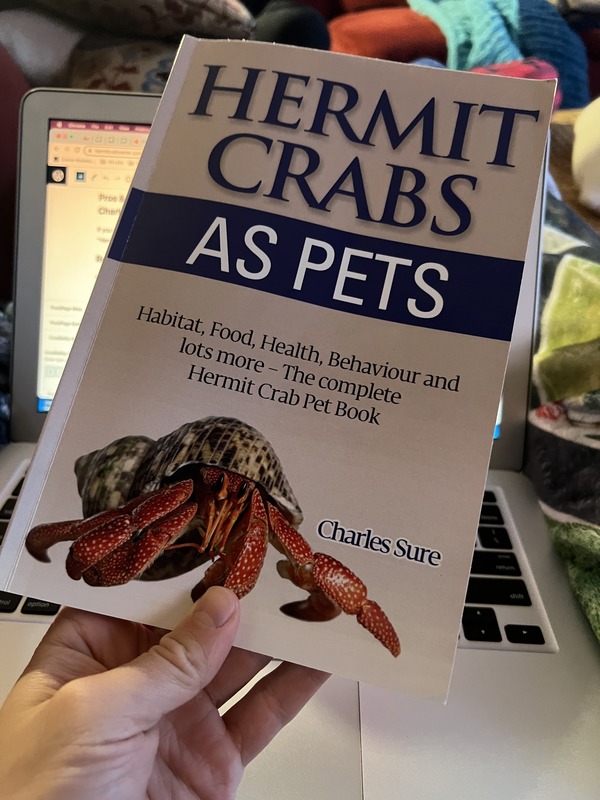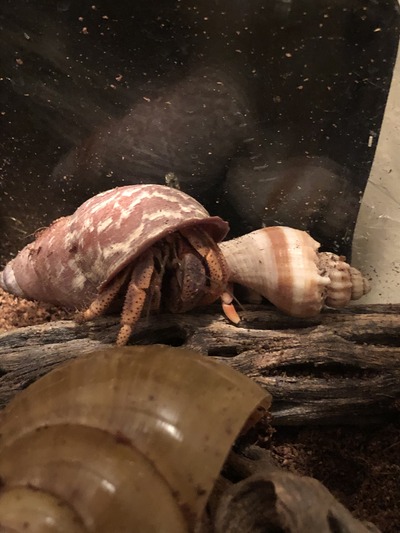While I was at Petco buying supplies for my hermit crabs, I stumbled upon their massive 100-gallon hermit crab tank. It was full of hermit crabs, big and small, scurrying back and forth.
Gazing at the crustaceans I began to wonder, do they do well together despite the size difference? I did some research to ease my curiosity. So, can different sized hermit crabs live together?
It’s better for different-sized hermit crabs to live together. Crabs of the same size are more prone to fight over new shells, which is the most common hermit crab conflict. Larger hermit crabs are not hostile towards smaller crabs, unless their needs are not being met.
Build your hermit crab tank to serve your largest hermit crab. It needs enough substrate to completely burrow for when it molts, and water bowls that are deep enough to fully submerge your crabs. As long as these needs are being met, large hermit crabs will have no problem sharing their space with smaller crabs.

Charles Sure in her book “Hermit Crabs as Pets” talks about shell conflicts. I’m reading it as I write this article. If you want to read this yourself, I bought it on Amazon (Affiliate link to Amazon product page).
Let’s take a look into everything you need to know to keep large and small hermit crabs.
Things To Keep In Mind

You need a solid, well functioning environment when keeping a variety of different-sized hermit crabs. To some, that means you need to make some changes before adding your different-sized crab.
Make Sure Each Crab Has His or Her Space
This is the number one reason why your hermit crabs wouldn’t get along, especially if there is a size difference, is if they don’t have enough space.
If you observe your crabs squabbling regularly and climbing on top of one another, this is most likely an issue. With many differently sized crabs, you will need a larger tank. It’s recommended that you have 3-5 gallons for every large crab and 2-5 gallons for every small crab.
Keep in mind that larger crabs need more food, larger shells, larger pools, and larger places to hide. This means more clutter in the tank and less room for the crabs to roam. Not only will this take up more time and money, but you also have the other crabs to think about.
It’s very important that they have enough room. If they’re cramped, they become hostile. Then, God forbid, the larger crabs might decide they’ve had enough of their smaller tankmates.
If you’re housing 3 or more crabs I would just go for a 20 to 40-gallon tank. It gives the little ones a place to hide if you have a larger crab and leaves plenty of room to grow.
Even though hermit crabs live in groups, they like their personal space. Each crab has his or her own spot in their tank they claim as their territory.
My two crabs, Dazzle and Clarke, are a great example. Clarke is a little smaller than Dazzle and hides in a small cut-out log during the day. Dazzle likes to hide on the opposite corner of the tank on the opposite side of the tank.
I have a 10-gallon tank which works just fine keeping my two small crabs. It’ll be a few years before I need to upgrade to a larger 20-gallon tank.
Meet Every Crab’s Needs
To avoid fighting and ensure that they get along, you’re going to have to stay consistent in taking care of your crabs.
Every day they need plenty of food, water, and a clean humid habitat. With that, they won’t any have reason to squabble.
Keep in mind that depending on the crab’s size, they will need more or less food and water.
You might have to adjust your pool sizes to make sure your crabs can submerge themselves in the water. Remember to add an easy way for them to escape!
Also, you might need more substrate. A good rule of thumb is to have 2 inches more bedding than the height of your largest hermit crab.
For example, if your largest crab is 3 inches tall, fill your tank with 5 inches of bedding. I recommend a mixture of damp coconut husks and play sand.
Lastly, you might need sturdier decorations for your crab to climb. Small, plastic plants will not hold larger crabs like they do smaller ones. I recommend large pieces of cholla wood. They’re great for climbing and can hold up very large hermit crabs.
Sometimes They Won’t Get Along
If you’re adding a whole bunch of different-sized hermit crabs to your tank, you might run into some grumps. This is fairly uncommon, though. Usually this is a sign that a hermit crab’s needs aren’t being met. So, keep this in mind.
Every once in a while you can tell when one crab just does not get along with their tankmate(s). If you’re sure you’re proving them with everything they need and still see bickering, there’s nothing you can really do. It is just the crab’s personality!
If you suspect foul play between your crabs, spend some time keeping an eye on them. After a bit, you’ll usually see one that clearly bullies the others to get its own way. The most common conflict between two hermit crabs are over a shell. This is usually between two hermit crabs of the same size.
If you notice this type of conflict happening, the best thing you can do is make sure there are enough shells to go around. Buy at least three shells for every hermit crab you own. Make sure they’re slightly larger than the shell they currently have so they can move up once they grow.
But that’s usually not the case. In fact, there are plenty of benefits to keeping larger and smaller hermit crabs together!
Different-sized hermit crabs fight less!
We, as pet owners, tend to fear the worst. It’s really easy to overthink and worry about what could happen or the worst possible scenario. There’s nothing wrong with that, it just means we love our pets.
So let me put your fears to rest when I tell you your differently sized hermit crabs will not only get along, there will be some benefits that come as well!
Different-sized tankmates will need different sized shells. At first, this may just look like a negative. You’ll have to buy more shells and you need more space for the shells.
This can be a headache but, in this case, it is a blessing in disguise! Different-sized shells mean less competition and fighting over who gets what shell. Say goodbye to shell fights since there are no crabs fighting over the same shell!
Another benefit, which is much more obvious, is that your crabs get another tankmate.
Despite their name, hermit crabs love being in large groups. You’ll rarely find a hermit crab on its own out in the wild. They mainly live in large groups.
Another hermit crab means another friend for its tankmates. Just be sure they have plenty of room, food, and water for your crabs and they’ll do just fine, no matter their size.
Related Questions
What Animals Can Live with Hermit Crabs
Other animals that can live with hermit crabs are isopods, Springtails, and food/soil mites. Not only are they harmless, but they also do a good job cleaning the tank.
Hermit crabs cannot live with pets other than those three. They are much too vulnerable when they molt.
How do I introduce a new crab to a hermit crab tank?
Before you introduce a new hermit crab to a tank, first, dip its shell in the tank’s saltwater pool for a few seconds. This will clean out any gunk and give it the tank’s scent. Its tankmates will be more accepting of a clean, familiar-smelling crab.
Works Cited
Sure, C. (2014). Hermit crab care: Habitat, food, health, behavior, shells, and lots more: The Complete Hermit Crab Care Pet Book … BLEP Publishing.
